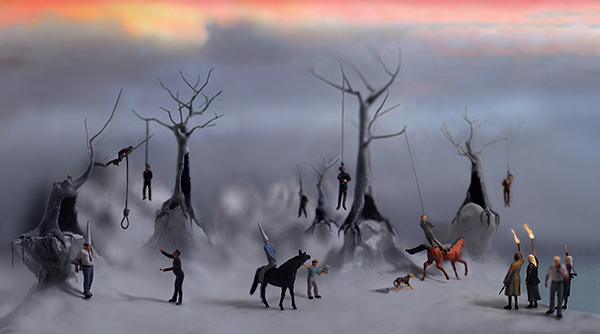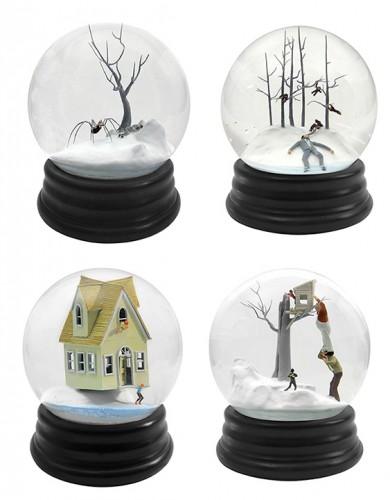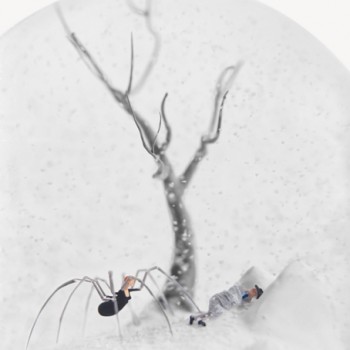Fanny Montgomery: Why did you start making art together?
Walter Martin: We were broke and sharing a small studio. The studio actually had only one serviceable wall for art viewing, so we shared that too. We worked in a similar fashion and were thinking along similar lines so it was not that difficult. In fact, we really liked looking at each other’s work. We were trying to surprise ourselves. That was the art “high” we were after: to surprise and inform, and we would strategize ways to do that. One of the strategies that made sense, considering our circumstances, was to mix our separate pieces. That was interesting, but too casual, so we went the next step and began our collaboration in earnest by making new work that was neither mine nor hers, but ours.
Where and when did you meet?
In March 1993 in New York. I was in a group show at a short lived gallery with a singular premise. The gallery was on Broadway below 12th street and had, only the month before, been an antiques store. The owner had hired an attractive French curator and given her a decent budget. His idea was to integrate contemporary art with his amazing collection of museum quality objects and furniture. It was a good idea but it did not play out that well. During the course of the show his stuff began little by little to creep into the forefront. He changed the exhibition daily by adding more antiques to the gallery floor. Needless to say there were many unwelcomed juxtapositions. Anyway, Paloma’s mother, Paloma Navares, was a pretty well-known Spanish installation artist who had been recruited by the French curator to have the first one person show in this new gallery. She had never shown in New York and did not speak a word of English. She had invited Paloma to come with her and to help translate, and so the two of them were there that same day. She wanted to meet me probably to see if I could shed some light on what was obviously a nonstandard gallery situation. So Paloma introduced her and we began to talk with Paloma standing between us. My English sentences went into Paloma’s ear and came out of her mouth in Spanish, and then from her mom back to me in English. During our conversation I found myself attracted to Paloma. Finally I said to Paloma, “Do you want to meet up for a drink later?” She turned to her mother without the slightest idea that I had intended to invite only her and translated my invitation to her mother. Her mother gladly accepted.
What is it like working with one another?
Working together with your best friend is a lot more fun than working alone. That is not to say we are in each other’s face all day. We don’t work in the same room or even on the same floor. We have our own areas and some additional space as well for shop machines, storage, and that sort of thing.

Walter Martin/Paloma Munoz-A March Sky
What is your process?
Our process varies from one aspect of our work to another. We have occasional public projects. Then there are the globes and the photography. Typically, one or the other will have an idea. We’ll discuss it and maybe do drawings and go back and forth with it. We do photographs of globes but also larger panoramas. Each of these types of photos are shot from sets. In the case of the globes we insert the set or scene in the globe, photograph it, and then exhibit it as an object. Unlike the globes which have a dual function, the larger sets that the panoramas are derived from are not exhibited. I do most of the set building while Paloma does the photography and also paints backgrounds for the panoramas. It is rare that an idea doesn’t morph in unanticipated ways before it is a finished. We can enter the endgame of a piece with a plan but it feels sometimes as if we both have our hands on the cursor of a Ouija board. We expect and look for uncertainty near the end. We want to get the process out of our control in hopes of finishing with a result that surprises us.
What are the benefits of working collaboratively as opposed to individually? Do you miss working on your own at all?
An obvious advantage of collaboration is the confluence of skill sets. There was a time when we tried to learn new skills together, but now we avoid skill redundancy and don’t waste time learning the same things. We each have our skills which we add to or improve on if possible. It’s not that we don’t work on our own, it’s just that what we do on our own often ends up in the larger mix of our collaboration.
How has your romantic relationship aided your art making? Is intimacy necessary in the joint creative process?
I am not sure. It is difficult to separate that aspect of our relationship from the whole. On a practical level, I don’t think the romantic aspect of our relationship is very pertinent to our day to day studio work, but it would be accurate to describe our collaboration as a couple’s project. We never had children or built a dream house and never wanted to. Instead we developed this more unconventional art project. We have created together a kind of fictive world in the globes and photos where we can explore the human condition through a series of narrative questions. I think we have some of the same feelings towards our work that other couples might have towards family; that paternal instinct to protect, nurture, and promote your offspring so that it may thrive. Our life together is all one piece. It is a diverse tapestry: weathered and worn, yes, but still growing and with a pretty tight weave. I don’t see how one could participate in a joint creative process without intimacy, but it need not be romantic.
How did you transition from more installation based work to the snow globes you’ve been creating lately?
We have been doing snow globes now for thirteen years. We did installations mostly in the nineties and started with the snow globes and photos in 2001. Our installations were very challenging and exciting for us. We probably had five or six solo shows together during the nineties but most of them went under the radar, and with a few exceptions nothing much came of them. When we did get great opportunities, like an invitation to exhibit our human candle pieces at the Istanbul Biennial we had to pass on them, for lack of funds. So we were pretty exhausted with that process of building things up and burning them down. It just wasn’t sustainable for us. The thing about the snow globes is that they are individually akin to drawings or short narrative sketches, and as such, demand a relatively small investment in terms of time, energy, and money as opposed to the installations with their epic feature length demands. Yet they can be building blocks to an installation if that is where you want to go, especially in conjunction with the large panoramas. The globes are versatile and can be grouped in various ways to achieve various objectives. I think our initial objective was to subvert the snow globe cliché, which we did in the first group we made. We could have stopped there and moved on to something else, but rather than discard this format we decided to develop it further. What we realized was that we had barely scratched the surface in terms of possibilities, and that the dystopian themes we had touched on in the first group had the latent potential to be teased out and developed in many interesting directions. Many of the sculptures’ themes are dark and foreboding.

Walter Martin/Paloma Munoz- Group of Snow Globes
Where does your desire to create things of this nature stem from?
I don’t think we have a desire to create things dark and foreboding. We don’t like to imagine that we take ourselves or our work that seriously. We definitely have a sort of gallows humor slant on the human condition, but it is lighter and more absurdist than serious. I think the dark and foreboding element that is a component of our globes could be seen as a conceptual prerequisite to imbuing the format with some authenticity. What I mean is that to subvert the cliché of the snow globe we had to invert its traditional at- tributes, one of which is the cloying kitsch of an idealized winter wonderland; but we also had to subvert the subversion. The subversion is also a cliché, so we had to imbue the snow globes with real humanistic content, and that is what surprised us about them. They had that potential to express universal emotion and feeling. It has been almost too much fun and we have lingered on it so long that it looks as if this is all we have ever done or will ever do. We are aware of this and are in fact going through one of those uncomfortable chrysalis stages at the moment.
Do you think your imaginations are naturally geared to produce eerie subject matter, or do you find yourself digging deep at times for inspiration and ideas?
I don’t think we are geared to produce eerie really. I do love eerie but in so far as our work is concerned, I think of it as a modifier as in eerie absurdism or eerie nihilism or eerie futurism. I see eerie as a quality of air that may appear in some of our narrative stills. It lends a kind of weighted atmosphere to a piece. I would not say that quality is something we consciously work for and I don’t see it as a common thread in our work. We are dedicated diggers. We root and scrap around in our cultural back and forth like pigs for truffles in the fall. We are still students, dilettantes really. We spend a lot of our time pursuing pet passions and letting our curiosity lead us off on digressions. Your collection of snow-globes invite the viewer to interact with it.
How do you think these sensory experiences enhance the art?
There are two interactive features of a typical snow globe. The flipping and shaking of the globe to agitate the snow is one that everyone is aware of. In most instances in regards to our scenes, this feature is annoying. In fact we often don’t bother including fake snow in the mix. The second feature, unlike the first, is interesting. The convex nature of the glass that encapsulates the scenes creates unpredictable distortions which change as one manipulates the globe. As one rotates the globe, the figures and parts within change, in subtle phantasmagoric ways, animating the scene and giving it a dynamic dimension.
In installations that feature sculpture as well as photographs, how do you create a relationship between the disparate pieces and mediums?
We started with the globes, but felt constrained by their scale in terms of an overall installation. By juxtaposing large photos of the scenes within the globes with the small globes, we felt we had widened the scale spectrum, putting the viewer somewhere in the middle. While, at the same time by means of these two mediums or formats, we were better able to develop our fictive world and give the viewer a more complete experience.
You have worked under the recent themes of Travelers, Night Fall, and Islands, so what’s next?
We are working on a new project of photography and sculpture. We are interested in utilizing our expressive toolkit to somehow capture the spirit of the rampant environmental destruction and pillaging of the commons that is an ongoing national corporate project in our area of eastern Pennsylvania. We are not interested in making agitprop, but as witnesses we would like to bottle some of this insanity for the future. There are very powerful anti-human forces afoot in our backyard. Nobody expects an artist to go out and slay the dragon, but it is our traditional role in society to turn our light in their direction and describe or interpret what we see. Even if all you can do is make fun of the monsters, that’s better than nothing.

Walter Martin/Paloma Munoz- Traveler
Why create? What motivates you to continue working?
Strong feelings that arise from one’s life experience like outrage, disgust, or fear need to be articulated or at least catalogued. Articulating is hard work, but it can be the force of that feeling that burns inside you that can fuel the fight to make a monument to its destruction or to mock it, whatever you’re good at. We really have no excuse to stop working short of being disabled, and certainly no reason to wonder why we should continue. There is so much unfinished business and unrealized potential. We just saw the documentary Salinger, which was interesting in this regard. I always thought of him as a kind of one hit wonder. Not in a disparaging way, of course. Catcher in the Rye seemed to be a classic example of getting something so right that nothing that followed could compare. So after publishing some lesser works, Salinger apparently throws up his hands in disgust and marches off into the woods to sit out the circus for the rest of his days. But the truth is he never gave up writing, he just gave up publishing. All those years of cantankerous seclusion were, as it turns out, well spent and fruitful. He was all those years typing away like a maniac in his bunker. At the time of his death, he had a vault of fully finished works whose publication dates are set to begin their orderly debut in 2015. One of those works deals with his war experiences, which were by all accounts horrific and probably the most difficult part of his life. One imagines it took him all those years in seclusion to turn that experience into something more rarified.
What is your biggest fantasy at the moment?
Walter Martin: I don’t know what to say. Not that I don’t have them. I don’t believe in them and I would feel silly describing them.
Paloma Muñoz: That we live in a virtual reality and that the day we die, we wake up, together, in an entirely new world.

